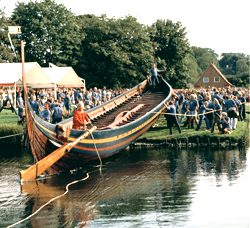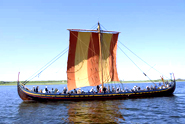Posted: 04 July 2007
Viking Warship sets sail for Dublin after almost 1,000 years
In 1962, archaeologists excavated five Viking ships from the bottom of the Roskilde Fjord in Denmark outside the village of Skuldelev. The official names for the wrecks were Skuldelev 1,2,3,5 and 6. The largest wreck, the Skuldelev 2 turned out to be the remains of an ocean-going warship built by Vikings in Dublin in 1042.
On 1 July 2007, 965 years after the original ship was built, a crew of 65, including UCD School of Archaeology student Triona Nicholl, set sail from Denmark to Dublin on the reconstructed Skuldelev 2.

Photo: Werner Karrasch
Triona has been in training for the voyage for the last two years. No one has manned a ship like this for more than 900 years. “This is the largest experimental archaeological event ever witnessed,” says Triona.
“All the crew members are volunteers. They have been selected by the Viking Ship Museum in Denmark on the basis of their seamanship, commitment, physical condition and special competencies,” she explains.
“Measuring 30m in length, the vessel is the largest reconstructed Viking Warship in the world. Built for speed and for carrying as many people as possible over the open sea and waters with strong currents, the Skuldelev 2 represents the absolute pinnacle of Viking shipbuilding technology.”
“Warships of this type allowed the Vikings to retain control and communication across vastly dispersed geographic areas.”
The original Viking Warship was constructed using mighty oak trees from Ireland’s ancient forests in the Dublin/Wicklow Mountains. The Skuldelev 2 was reconstructed over the course of 4 years using the same materials and techniques that were used to build the original.
The complete reconstruction was unveiled on 4 September 2004 by Her Royal Highness Queen Margrethe who christened the ship ‘Havhingsten fra Glendalough’ (the Sea Stallion from Glendalough).
The Sea Stallion will voyage under Viking Age conditions across the actual waters that the original ship was built to cross. It is estimated that the ship will arrive in Dublin at the beginning of August 2007 – roughly six weeks after leaving Roskilde.
The route from Denmark to Dublin will take the crew through the Limfjord to Thyboron, where they will wait for favourable wind to tack over Skagerrak to Stavanger in Norway. From there the reconstructed Viking warship will sail to the Orkney Islands, around the northern coast of Scotland and head southwards across the Irish Sea to Dublin.
The leg across from Stavanger to the Orkneys is 240 nm (450km). And depending on the weather conditions and winds, this part of the voyage will last 2-5 days and nights. But the most difficult part follows: the churning waters north of Scotland and in the Irish Sea. Characterised by great tidal amplitude, strong currents, and rough weather, these waters will be extremely difficult for the ship to cross. When the strong current is moving outwards it meets the swell from the Atlantic Ocean, which creates steep waves constituting a significant risk to an open boat. The unforecasted storms and dense fog which are also common to these areas challenge sailor’s skills to their limit.
To coincide with the ships arrival in Dublin, a week of activities and events are planned at Custom House Dock and the National Museum of Ireland. The reconstructed Viking Warship will go on public view at the National Museum of Ireland where it will overwinter before sailing back to Denmark in 2008. An exhibition tracking the voyage is currently taking place at the National Museum of Ireland.
Archaeologists believe that the original Skuldelev 2 may have played a part in the diplomatic crisis following the Battle of Hastings in 1066 when the Danes lost supremacy in England. The battle marked the end of the Viking Age.
To follow the Viking Warship on its voyage to Dublin visit www.seastallion.dk

